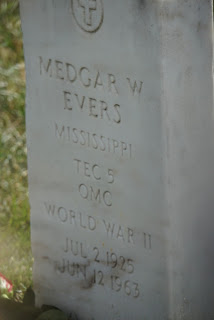The group visited Arlington today. We had a tour guide who made it a point to walk us through the cemetery to graves that each offered stories about Normandy that we might not have otherwise known. Our trip there lasted about three hours, and I'm appreciative of how it gave me a much better sense of how large this cemetery is. Here are the graves we visited as part of the tour.
 |
| A black veteran of the Normandy Invasion. |
 |
| One of the first women ashore at Normandy. She eventually set up communications at the Potsdam Conference. |
 |
| Commander of some of the Airborne troops who served at Normandy. |
 |
| Eventually served as commanding general in Korean War. |
 |
| One of Eisenhower's architects for the invasion. |
 |
| Eisenhower's boss. |
 |
| One of America's Hispanic veterans of the Normandy campaign. |
 |
| Lauren's grandfather. |
 |
| Zac's grandfather. |
 |
| Famous boxer who took down Max Schmeling. |
 |
| Supreme Court Justice |
 |
| Civil Rights Movement Leader and Martyr |
 |
| At the grave of a famous fighter pilot, one who flew my favorite plane from the war. |
 |
| I thought this might be Dylan's airman's group, but it wasn't (right Air Force, though). |



Comments
Post a Comment